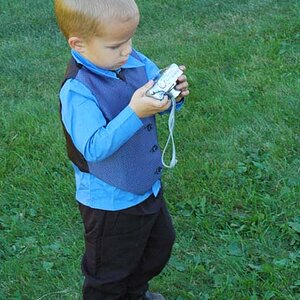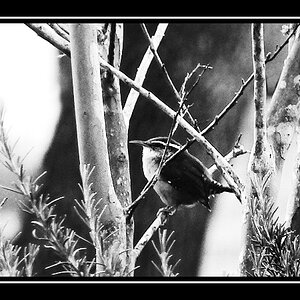These discussions amaze me sometimes. If you don't understand the difference, usually you don't need the faster glass. If you do understand the difference and are willing to pay for it then great, and if you aren't willing to pay for it, well that just fine as well. It comes down to personal choices.
Navigation
Install the app
How to install the app on iOS
Follow along with the video below to see how to install our site as a web app on your home screen.

Note: This feature currently requires accessing the site using the built-in Safari browser.
More options
You are using an out of date browser. It may not display this or other websites correctly.
You should upgrade or use an alternative browser.
You should upgrade or use an alternative browser.
Cost of High Quality Glass vs. Photos
- Thread starter Vautrin
- Start date
DWS
TPF Noob!
- Joined
- Apr 19, 2008
- Messages
- 118
- Reaction score
- 0
- Can others edit my Photos
- Photos NOT OK to edit
It comes down to personal choices.
Garbz
No longer a newbie, moving up!
- Joined
- Oct 26, 2003
- Messages
- 9,713
- Reaction score
- 203
- Location
- Brisbane, Australia
- Website
- www.auer.garbz.com
- Can others edit my Photos
- Photos NOT OK to edit
This honestly doesn't show me anything. The only way is going to be accurately showing the same images with both bad and good lenses. When I look at the flowers, I see a cheaper quality lens. It's hard to tell in the first image because it's a very contrasty image. These images are too small to REALLY get the fine details of the difference in lenses... and don't forget, images can be "doctored up" in photoshop. For instance, I coudl take your flower image and really make it pop in PhotoShop and at this smaller resolution, you probably won't be able to tell hugely the difference in the quality of lenses, but at higher rez, absolutely.
I do agree, there are sweet spots in lower quality lenses, but for consistancy in better color and quality, and speed of the lenses, the higher quality lenses are the way to go, hands down.
I'm at the point in my career where I wouldn't touch a cheap lens for clients. Ever. I also wouldn't go less than a D700 or D3 in the Nikon end of things for clients (however, I even just bought my first point and shoot and shared a few images on my blog with it - but it was for family vacation).... but everyone is different.
You've kind of made a good point here. Images can be doctored up. These images were made by cheap lenses but look great. This says a lot. It's not a comparison but it does show that the cost of entry into photography is low and excellent results can be achieved for little money. Is it worth $2000 to save yourself some time carefully sharpening in photoshop? Not to you but to some quite possibly.
It's the economics of the situation. I have a bit of money and I LOVE photography. But really my girlfriend takes fantastic pictures too but her Olympus kit lenses have far higher utility because she doesn't sleep next to her camera.
You mentioned clients. I would like to say no person who seriously has "clients" should consider cheap glass or a solid magnesium alloy body. It's the reliability of it. Once you do it professionally the overriding factor should not be does $2000 lens increase the quality of my image by 1%, it should be does the $2000 lens potentially prevent me from embarrassing reputation ruining equipment failure.
- Joined
- Sep 2, 2005
- Messages
- 14,455
- Reaction score
- 3,328
- Can others edit my Photos
- Photos OK to edit
This honestly doesn't show me anything. The only way is going to be accurately showing the same images with both bad and good lenses. When I look at the flowers, I see a cheaper quality lens. It's hard to tell in the first image because it's a very contrasty image. These images are too small to REALLY get the fine details of the difference in lenses... and don't forget, images can be "doctored up" in photoshop. For instance, I coudl take your flower image and really make it pop in PhotoShop and at this smaller resolution, you probably won't be able to tell hugely the difference in the quality of lenses, but at higher rez, absolutely.
I do agree, there are sweet spots in lower quality lenses, but for consistancy in better color and quality, and speed of the lenses, the higher quality lenses are the way to go, hands down.
I'm at the point in my career where I wouldn't touch a cheap lens for clients. Ever. I also wouldn't go less than a D700 or D3 in the Nikon end of things for clients (however, I even just bought my first point and shoot and shared a few images on my blog with it - but it was for family vacation).... but everyone is different.
1. As I've said numerous times and various ways, I'm not saying the lenses I was using are a match for higher quality glass. I'm merely saying that lower quality glass shouldn't necessarily be dismissed out of hand. It has it's uses, depending on circumstances and needs and experience.
2. You are correct, with images this small it is QUITE hard to tell. The statues image is a significantly higher quality image... but then, the flower pic was taken nearly 10 years earlier when I had far less clue what I was doing... was taken with a Canon AE1 (vs. the D300 that took the statues), and was scanned from the negative. At full size, you can tell a significant difference. That, however, was not my point.
3. As I've said about a million times, better equipment is going to give you a higher ceiling on quality, and if you're a pro you're going to be able to tell the difference... but frankly some person wandering in here off the street and ASKING WHAT THEY NEED is going to have quite a bit of time before they're going to be able to take true advantage of that equipment, and frankly quite a bit of time before they will be able to tell the difference.
Again and again and again.
- Joined
- Sep 2, 2005
- Messages
- 14,455
- Reaction score
- 3,328
- Can others edit my Photos
- Photos OK to edit
You've kind of made a good point here. Images can be doctored up. These images were made by cheap lenses but look great. This says a lot. It's not a comparison but it does show that the cost of entry into photography is low and excellent results can be achieved for little money. Is it worth $2000 to save yourself some time carefully sharpening in photoshop? Not to you but to some quite possibly.
I don't think that was her point, but I love the way you backhanded it.

BTW, these images are not doctored. Light sharpening pass, minor color balance adjustments and a touch of contrast. No more than I would do with any image. Actually, the flowers one wasn't doctored AT ALL... I scanned that years ago and didn't even know how to use photoshop at the time. It could actually use a bit of help.

- Joined
- Jul 8, 2005
- Messages
- 45,747
- Reaction score
- 14,806
- Location
- Victoria, BC
- Website
- www.johnsphotography.ca
- Can others edit my Photos
- Photos OK to edit
Always buy the best gear you can afford. There's not a lot of point in looking at examples of good and bad lenses on-line, since only the most extreme quality issues are going to be clearly visible (other than things such as barrel and pincushion distortion) on all but the best monitors.
Even if you never use the maximum aperture of a lens, the overall results are still going to be better than a cheap lens. Are they going to be that much better that you can justify the price? Again, only you can decide.
Even if you never use the maximum aperture of a lens, the overall results are still going to be better than a cheap lens. Are they going to be that much better that you can justify the price? Again, only you can decide.
Derrel
Mr. Rain Cloud
- Joined
- Jul 23, 2009
- Messages
- 48,225
- Reaction score
- 18,941
- Location
- USA
- Website
- www.pbase.com
- Can others edit my Photos
- Photos OK to edit
The three lenses the OP mentions are shown here, side by side Zuiko Digital ED 14-35mm F2.0 SWD Review | PhotographyBLOG
in the review of the 14-35mm f/2 lens, which translates roughly to a 28-70mm f/2 on 35mm full-frame sized capture. Given the very small capture size of the 4/3 format, I would think that Olympus pros would like the shallower depth of field effects possible with a highly-corrected f/2 lens shot wide open,or stopped down a bit to f/2.8 to f/3.5.
The 14-35 f/2 weighs just under three pounds. It's positively huge compared with the small,light consumer model,and about 30 percent larger than the mid-level lens. Looking through the review I linked to, what I see from the f/2 model is very good center AND edge sharpness,and a very consistently high-quality optical performance. I also looked on pBase, and I think the way the f/2 lens draws looks very nice. The bokeh also looks pretty good too, in the few natural-world sample photos I looked at.
If you've never owned top-end glass, it's hard to imagine why it costs so much, but given the small capture size of 4/3 and the noise disadvantage it has, I think the two f/2 zooms Olympus has designed *expressly for* their 4/3 cameras is a concession to those who want to absolutely wring every last bit of performance out of a 4/3 camera.
Honestly, if you need this lens, you know you need it,and you know why you need it. If you have to ask about it, you might consider something lighter and smaller than a three-pound, $2,000 lens.
in the review of the 14-35mm f/2 lens, which translates roughly to a 28-70mm f/2 on 35mm full-frame sized capture. Given the very small capture size of the 4/3 format, I would think that Olympus pros would like the shallower depth of field effects possible with a highly-corrected f/2 lens shot wide open,or stopped down a bit to f/2.8 to f/3.5.
The 14-35 f/2 weighs just under three pounds. It's positively huge compared with the small,light consumer model,and about 30 percent larger than the mid-level lens. Looking through the review I linked to, what I see from the f/2 model is very good center AND edge sharpness,and a very consistently high-quality optical performance. I also looked on pBase, and I think the way the f/2 lens draws looks very nice. The bokeh also looks pretty good too, in the few natural-world sample photos I looked at.
If you've never owned top-end glass, it's hard to imagine why it costs so much, but given the small capture size of 4/3 and the noise disadvantage it has, I think the two f/2 zooms Olympus has designed *expressly for* their 4/3 cameras is a concession to those who want to absolutely wring every last bit of performance out of a 4/3 camera.
Honestly, if you need this lens, you know you need it,and you know why you need it. If you have to ask about it, you might consider something lighter and smaller than a three-pound, $2,000 lens.
Moglex
TPF Noob!
- Joined
- Jun 13, 2008
- Messages
- 581
- Reaction score
- 0
- Location
- Whitstable
- Can others edit my Photos
- Photos OK to edit
There's plenty of information "out there" for you to decipher this for yourself.
I'll take that as an 'I don't know'. :mrgreen:
JerryPH
No longer a newbie, moving up!
- Joined
- Oct 14, 2007
- Messages
- 6,111
- Reaction score
- 15
- Location
- Montreal, QC, Canada
- Can others edit my Photos
- Photos NOT OK to edit
I find a very large difference in between different lenses in the pro class, much less comparing low end consumer glass to pro glass.
You definitely get what you pay for!
You definitely get what you pay for!
Aye-non Oh-non Imus
TPF Noob!
- Joined
- Nov 18, 2007
- Messages
- 516
- Reaction score
- 23
- Can others edit my Photos
- Photos OK to edit
Take it in anyway that makes you feel good. As far as Oly gear is concerned, you are correct. As far as lens design is concerned, you are sorely mistaken.I'll take that as an 'I don't know'. :mrgreen:
If you haven't the understanding on the difference between fixed, variable and constant apetures, then truely, the information is "out there" for you. I suggest some additional research on your part. My comment "I don't like variable apeture on zooms" was from a point of experience, which suits my drothers, style of shooting...... and my wallet.
Now granted, I like to be a smartass as much as the next guy, but I really try to veil my bull$hit so that it's almost believable, or at least, makes the person that questions it investigate further to call me on it. Your comment "Surely, if you have a fixed aperture what you really have is a variable aperture limited to the smallest wide open value" is rice paper thin and makes me think that you really haven't thought this through.
Peace.
JerryPH
No longer a newbie, moving up!
- Joined
- Oct 14, 2007
- Messages
- 6,111
- Reaction score
- 15
- Location
- Montreal, QC, Canada
- Can others edit my Photos
- Photos NOT OK to edit
New forum rules... "bull$hit" and "peace" cannot be in the same post... makes it hard to retort with any great level of passion. :lmao:
Aye-non Oh-non Imus
TPF Noob!
- Joined
- Nov 18, 2007
- Messages
- 516
- Reaction score
- 23
- Can others edit my Photos
- Photos OK to edit
New forum rules... "bull$hit" and "peace" cannot be in the same post... makes it hard to retort with any great level of passion. :lmao:
 Go ahead and give it your worst. Peace was just a signoff for moglex, as ín, stick a fork in it çause I'm done.
Go ahead and give it your worst. Peace was just a signoff for moglex, as ín, stick a fork in it çause I'm done.Moglex
TPF Noob!
- Joined
- Jun 13, 2008
- Messages
- 581
- Reaction score
- 0
- Location
- Whitstable
- Can others edit my Photos
- Photos OK to edit
Take it in anyway that makes you feel good. As far as Oly gear is concerned, you are correct. As far as lens design is concerned, you are sorely mistaken.I'll take that as an 'I don't know'. :mrgreen:
If you haven't the understanding on the difference between fixed, variable and constant apetures, then truely, the information is "out there" for you. I suggest some additional research on your part. My comment "I don't like variable apeture on zooms" was from a point of experience, which suits my drothers, style of shooting...... and my wallet.
Now granted, I like to be a smartass as much as the next guy, but I really try to veil my bull$hit so that it's almost believable, or at least, makes the person that questions it investigate further to call me on it. Your comment "Surely, if you have a fixed aperture what you really have is a variable aperture limited to the smallest wide open value" is rice paper thin and makes me think that you really haven't thought this through.
Peace.
I note you still haven't given any indication that you know the answer.
I'm afarid it's extremely hard to take seriously anyone who consistently spells 'aperture': 'apeture'.
Perhaps you could start to gain just a grain of credibity by giving us an example of any commony available zoom that does not have a variable aperture.

Aye-non Oh-non Imus
TPF Noob!
- Joined
- Nov 18, 2007
- Messages
- 516
- Reaction score
- 23
- Can others edit my Photos
- Photos OK to edit
Pot, kettle, who knows. I know, I know..... sometimes we get on a roll and just roll with it.I'm afarid it's extremely hard to take seriously anyone who consistently spells 'aperture': 'apeture'.
Perhaps you could start to gain just a grain of credibity by giving us an example of any commony available zoom that does not have a variable aperture.
I'll start with the Holy Trinity
Nikkor 14-24mm f/2.8
Nikkor 24-70mm f/2.8
Nikkor 70-200mm f/2.8
I think the part you're not clocking on to is that a constant aperture is constant throughout the zoom range. So I can get an f/2.8 at 14mm as well as at 24mm as opposed to having to suffer the f/3.5 at the wide end to f/5.6 at the other end of the zoom range from the consumer lens. It's a given that these lenses can adjust the aperture from f/2.8 to f/22.
Last edited:
Moglex
TPF Noob!
- Joined
- Jun 13, 2008
- Messages
- 581
- Reaction score
- 0
- Location
- Whitstable
- Can others edit my Photos
- Photos OK to edit
Perhaps you could start to gain just a grain of credibility by giving us an example of any commony available zoom that does not have a variable aperture.
I'll start with the Holy Trinity
Nikkor 14-24mm f/2.8
Nikkor 24-70mm f/2.8
Nikkor 70-200mm f/2.8
They all have a variable aperture.
I think the part you're not catching on to is that a constant aperture is constant throughout the zoom range. So I can get an f/2.8 at 14mm as well as at 24mm as opposed to having to suffer the f/3.5 at the wide end to f/5.6 at the other end of the zoom range from the consumer lens.
That is a constant maximum aperture, not a non-variable aperture.
It's a given that these lenses can adjust the aperture from f/2.8 to f/22.
Indeed. That's why they are not fixed aperture.
My question, which was perfectly sensible and reasonable to anyone who had even a little knowledge about lens design was whether any lens had been designed and built that had in some way a naturally constant maximum aperture (I'm pretty sure the answer is no), rather than an aperture that changed in f-number as the focal length changed but had been constrained to a fixed maximum value.
Your completely unwarranted aggression in response to that question and your continued failure to make even the most basic attempt to answer it would seem to indicate that you are way out of your depth.
Similar threads
- Locked
- Replies
- 26
- Views
- 4K
- Replies
- 64
- Views
- 8K
- Replies
- 5
- Views
- 512

![[No title]](/data/xfmg/thumbnail/33/33491-46949ced4f9729f095cb48c6c61633db.jpg?1619736003)




![[No title]](/data/xfmg/thumbnail/39/39271-04ff6ce1fbcda2b0d41ad7ee08cff91a.jpg?1619738950)





